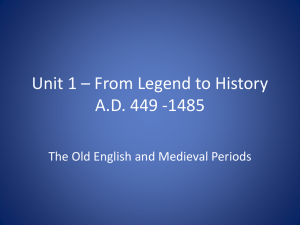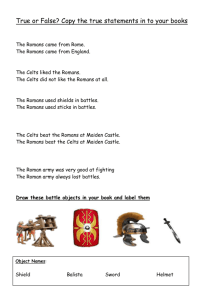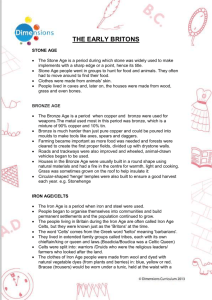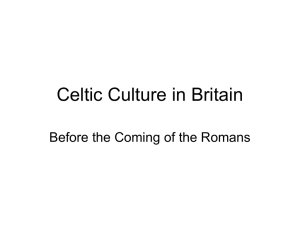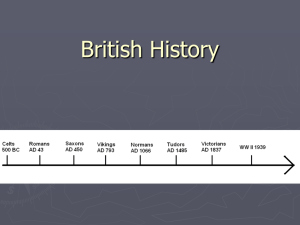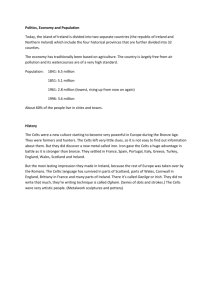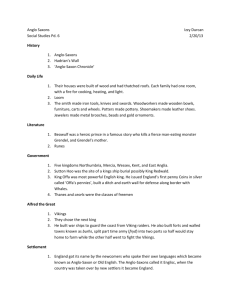UK readings33 KB
advertisement
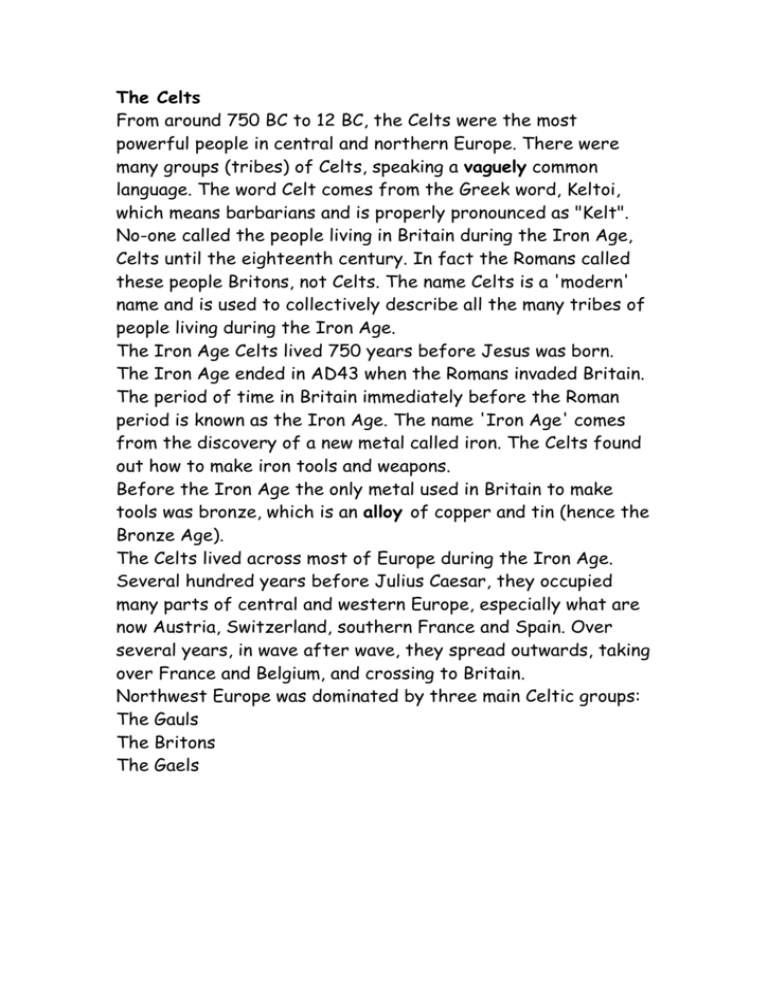
The Celts From around 750 BC to 12 BC, the Celts were the most powerful people in central and northern Europe. There were many groups (tribes) of Celts, speaking a vaguely common language. The word Celt comes from the Greek word, Keltoi, which means barbarians and is properly pronounced as "Kelt". No-one called the people living in Britain during the Iron Age, Celts until the eighteenth century. In fact the Romans called these people Britons, not Celts. The name Celts is a 'modern' name and is used to collectively describe all the many tribes of people living during the Iron Age. The Iron Age Celts lived 750 years before Jesus was born. The Iron Age ended in AD43 when the Romans invaded Britain. The period of time in Britain immediately before the Roman period is known as the Iron Age. The name 'Iron Age' comes from the discovery of a new metal called iron. The Celts found out how to make iron tools and weapons. Before the Iron Age the only metal used in Britain to make tools was bronze, which is an alloy of copper and tin (hence the Bronze Age). The Celts lived across most of Europe during the Iron Age. Several hundred years before Julius Caesar, they occupied many parts of central and western Europe, especially what are now Austria, Switzerland, southern France and Spain. Over several years, in wave after wave, they spread outwards, taking over France and Belgium, and crossing to Britain. Northwest Europe was dominated by three main Celtic groups: The Gauls The Britons The Gaels The Romans The Romans invaded England in 43 AD. They landed in Kent, made their way to the River Thames and sailed up it. The Romans knew it was important to control a crossing point at the river Thames, so they decided to build a settlement on the north bank. They chose a spot in two small hills and where the river became narrower. They built a bridge over the Thames, and there has been a 'London Bridge' in the same area ever since. The Romans laid out buildings, streets and a port, and shortly afterwards they built a bridge. They called the settlement Londinium and it soon became the capital of Roman Britain. In AD 61 the native Iceni tribe, led by Queen Boudicca, rose up against the Romans. They burnt Londinium to the ground and killed all its inhabitants. The Romans regained control and rebuilt London, this time adding a Forum (market) and Basilica (a business centre), and slowly building a wall around the city to protect it from further invasion. The Romans ruled in Britain until 410. The population of Roman London was between 12,000 and 20,000. In Roman times, the River Thames was 300 meters wide (today it is 100 meters wide). Saxons and the Vikings Later in the 5th century, Anglo-Saxons settled just west of Londinium and formed the town of Lundenwic. Saxon London consisted of many wooden huts with thatched roofs. Disaster struck London in 842 when the Danish Vikings looted London. They returned in 851 and this time they burned a large part of the town. King Alfred the Great totally defeated the Danes in 878 and they split the country between them. The Danes took eastern England including London while Alfred took the South and West. Despite the peace treaty Alfred's men took London in 886. Alfred repaired the walls of the old Roman town. In 1016 the Vikings attacked London again but this time the Saxons fought them off. London Bridge is falling down, Falling down, falling down, London Bridge is falling down, My fair lady." It is thought that this nursery rhyme probably records an attack against London by the Viking, Olaf, at the beginning of the 11th Century. King Olaf of Norway attacked England but he was unable to sails up the Thames past London Bridge. At that time London Bridge was made of wood. Olaf and his men tied ropes to the wooden struts supporting it. They then rowed away and London Bridge collapsed. The Vikings and Saxons ruled jointly England until 1042, when Edward the Confessor became King of both the Vikings and the Saxons. Edward the Confessor (1042-1066) built a wooden palace at Westminster. Later Parliament met here. Because of this Westminster became the seat of government not the city of London itself. Edward also built Westminster Abbey, which was consecrated a few weeks before his death. Christianity grew stronger in Anglo-Saxon Britain. In 604 AD a cathedral was founded in London and named after the apostle, Saint Paul. There is still a cathedral on the site. The Battle of Hastings At first the Normans were unable to pierce through the massed ranks of the English infantry. For six hours until late afternoon the English seemed like they were going to win. The Normans charged again and again, but they couldn't break through the Saxon shield wall and had to go back down the hill again. The Saxon's shield wall was a tough defense Then the Saxons made their fatal mistake. Late afternoon some of Harold's men broke their shield wall to chase the Normans, who they thought were retreating. This was to be their biggest mistake because no sooner had the Normans reached the bottom of the hill; they turned round and cut the English to bits. The Norman cavalry rode among the English, hacking them down. Finally, William brought in his archers and Harold's luck ran out. The arrows didn't break the Saxon line, but if the Bayeux Tapestry is to be believed, one of the arrows hit Harold in the eye. The battle lasted six hours. Why did William win? His army simply had time to rest before the battle. Harold Godwinson's army was tired and they did not have time to prepare properly for the battle. The English army had already fought the Battle of Stamford Bridge that day and had to march quickly down to the battlefield outside Hastings. They marched 50 miles a day! William's army was stronger. He had better trained soldiers and had the use of a strong cavalry (men on horseback) and archers whereas Harold did not. William's army pretended to flee. Many of Harold's men broke their shield wall to chase after them but as they did William and his army turned back and slaughtered them.
